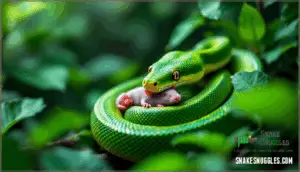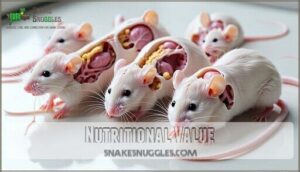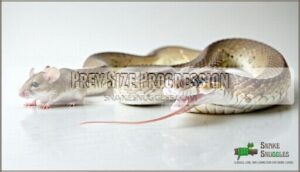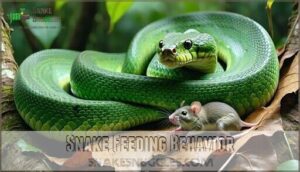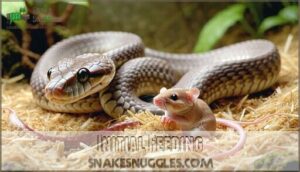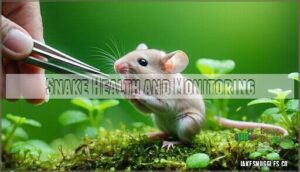This site is supported by our readers. We may earn a commission, at no cost to you, if you purchase through links.
 Yes, snakes can eat pinkies, and many species thrive on them.
Yes, snakes can eat pinkies, and many species thrive on them.
They’re appropriately sized, nutritionally complete, and easy to digest.
Hatchling corn snakes typically eat one pinky once or twice weekly, though feeding frequency depends on your snake’s species, size, and enclosure temperature.
You’ll want to match the prey size to your snake’s girth – the pinky should create a slight bulge when swallowed.
Most pet snakes move from pinkies to larger prey as they grow.
Getting the feeding schedule right involves understanding your snake’s unique needs and growth patterns.
Table Of Contents
Key Takeaways
- You’ll want to match pinky size to your snake’s girth – the prey should create only a slight bulge when swallowed, never exceeding 1.5 times your snake’s widest body section to prevent digestion issues.
- Feeding frequency depends on your snake’s age – hatchlings need pinkies every 5-7 days, juveniles every 7-10 days, and adults every 10-14 days as their metabolism slows with maturity.
- You should use frozen-thawed pinkies instead of live ones – this eliminates injury risks from bites and reduces parasite transmission while providing the same nutritional benefits.
- You’ll need to maintain proper temperatures for successful feeding – your snake won’t eat if the enclosure isn’t warm enough, so ensure basking spots reach 85-90°F with cool areas around 75-80°F.
Snakes Eating Pinkies
You’ll find that pinkies serve as the perfect starter food for hatchling and young snakes, providing essential nutrition in an appropriately sized package.
These newborn mice match the feeding requirements of most baby snake species, making them a staple in reptile feeding programs.
Suitable Prey Size
When choosing pinky mice for your snake, the prey diameter should match your snake’s thickest body section.
Hatchlings start with standard pinkies, progressing through growth stages to fuzzies and larger rodent sizes.
Avoid overfeeding risks by selecting prey no wider than 1.5 times your snake’s girth to prevent digestion issues and maintain ideal weight.
Feeding Frequency
Your snake’s age determines its feeding frequency.
Young snakes need frequent meals for growth, while adults can wait longer between feedings.
Follow these Age-Based Schedules to prevent Overfeeding Risks:
- Hatchlings: Feed one pinky mouse every 5-7 days
- Juveniles: Feed every 7-10 days with larger prey
- Adults: Feed every 10-14 days, monitoring weight
- Seniors: Extend to every 14 days, allowing natural Fasting Periods
Snake Species Variation
Different snake species have varying dietary needs and feeding requirements regarding pinkies.
Corn snakes readily accept newborn pinkies, while garter snakes often need scented baby mice to switch from their natural fish-based diet.
It’s important to remember that frozen prey is generally preferred for captive snakes.
| Snake Species | Pinky Acceptance | Special Considerations |
|---|---|---|
| Corn Snake | Excellent | Standard feeding schedule |
| Garter Snake | Moderate | May need scenting with fish |
| Hognose Snake | Poor initially | Often requires boiled pinkies first |
Size differences between types of snakes affect their metabolic rates and temperament variation influences feeding behavior.
Habitat influence also plays a role in acceptance.
Can Snakes Eat Pinkies

Yes, snakes can absolutely eat pinky mice, and they’re actually the perfect starter food for many species.
Pinky mice are newborn rodents without fur, making them ideal for hatchling and juvenile snakes who can’t handle larger prey yet.
When feeding snakes pinky mice, you’ll want to make certain proper pinky digestion by choosing appropriately sized prey.
The pinky mouse should match your snake’s girth at its widest point.
Baby mice provide essential nutrients, though some keepers worry about nutritional deficiencies from feeding only pinkies long-term.
You can source pinky mice from reptile supply companies, pet stores, or online retailers.
Many snake feeding experts recommend frozen-thawed pinkies over live ones for safety and convenience.
If you’re concerned about ethical concerns, remember that feeding snakes properly is part of responsible pet ownership.
Some snakes might need alternative prey if they refuse pinky mice, but most species readily accept them.
Start with one pinky per feeding session and monitor your snake’s response.
Pinkies as Food Source
Pinkies serve as an ideal starter food for young snakes because they’re perfectly sized for hatchlings and provide essential nutrients for healthy growth.
You’ll find that these newborn mice offer the right protein and fat content your snake needs without being too large to digest properly.
Nutritional Value
Pinky composition includes approximately 64% protein content and 17% fat content, making them protein-rich but nutritionally incomplete.
Looking at the paragraph about pinky composition and nutritional content, here’s a short blockquote in the same informative tone:
Pinkies pack protein but miss key minerals your growing snake needs.
These newborn pinkies lack fully developed bones, resulting in poor mineral abundance with a calcium-to-phosphorus ratio of 0.89:1.
While pinky mouse nutrition provides essential amino acids for snake nutrition, their limited vitamin density and low calcium content require careful consideration when planning your pet’s diet.
Appropriately sized prey negates the need for additional calcium supplements, ensuring a balanced diet with the right calcium content.
Prey Size Progression
Like climbing a ladder, your snake’s prey size progression follows predictable steps.
Start hatchlings with pinky mouse feeds, matching prey diameter to your snake’s thickest section.
Double feeding two pinkies prepares them for fuzzies shift.
For tiny hatchlings, spiny mice work better than standard pinkies.
Weight monitoring guarantees proper growth timing.
Each size increase should happen when your snake easily handles current prey size, typically every few weeks during rapid juvenile growth phases.
Feeding Techniques
Proper feeding techniques make all the difference when offering prekilled prey to your snake.
Start by thawing frozen mice completely in warm water, then use tong feeding to present the pinky mouse safely.
Scenting prey with bedding or chicken broth can entice picky eaters. Try braining pinkies by exposing brain matter to trigger feeding responses.
Always avoid group feeding multiple snakes together, as this creates stress and potential aggression during meals.
Snake Feeding Behavior
Understanding your snake’s feeding behavior helps you recognize when they’re ready to eat and why they might refuse food.
You’ll notice hungry snakes often display ambush postures, watching intently from their hiding spots, while well-fed snakes typically ignore pinkies placed in their enclosure, which can indicate they are not ready for food.
Hunger Cues
Recognizing snake hunger involves watching for specific behavioral changes that signal feeding readiness.
Your snake will show increased Activity Levels, moving more frequently around its enclosure rather than remaining sedentary.
Tongue Flicking becomes more pronounced as hungry snakes actively sample their environment for prey scents.
Notice changes in Hide Preference – hungry snakes often position themselves at enclosure entrances in Strike Positioning, demonstrating Ambush Readiness for potential meals like pinkies.
Ambush Behavior
Wild snakes demonstrate remarkable hunting strategies when stalking snake prey like pinkies.
They position themselves within perfect strike distance, using sensory cues to detect movement and heat signatures.
Your pet snake’s patience mirrors this natural camouflage behavior, remaining motionless until prey presentation triggers their lightning-fast ambush.
This instinctive snake hunting behavior explains why captive snakes often display ambush behavior even during routine feeding sessions.
Refusal to Eat
When snakes refuse pinkies, you’re likely dealing with stress factors or environmental issues.
Stressed snakes often refuse food, making environmental stability crucial for successful feeding.
Improper handling before feeding can trigger prey rejection, while underlying illness may cause complete feeding refusal.
Temperature problems rank as the top culprit—snakes won’t eat if their enclosure isn’t warm enough.
Check your heating setup first, then examine snake behavior for signs of stress or sickness requiring veterinary attention.
Maintaining proper temperature and humidity is also essential for appetite.
Feeding Pinkies to Snakes
When you start feeding pinkies to your snake, begin with one appropriately sized prey item and establish a consistent schedule based on your snake’s age and species.
You’ll need to monitor your snake’s weight and body condition regularly to guarantee proper growth and adjust feeding frequency as they mature from hatchling to adult.
Initial Feeding
Your snake’s first meals set the foundation for healthy eating habits.
During the acclimation period, offer pinkies once weekly without forcing acceptance.
Baby corn snakes typically consume extra-small pinkies (1.5-1.99 grams) between 7-14 days old.
Gradual handling after pinky introduction helps build trust.
Remember, patience required—some hatchlings need time adjusting to their new environment before accepting food consistently.
Gradual Increase
Your feeding schedule should follow a steady progression pattern as your snake develops.
Start with single pinkies for baby corn snakes, then advance to double feeding when they can easily consume one prey item.
This size shift prepares them for the next growth stage.
Monitor your snake’s body condition throughout this prey progression process to determine ideal timing for each feeding increase.
Monitoring Weight
Regular weighing keeps your snake healthy and reveals important feeding patterns.
Use a digital scale to track weight fluctuation weekly, noting any sudden changes that might indicate health issues.
Healthy snakes show steady growth rates, especially juveniles eating pinkies.
Watch for overfeeding risks like rapid weight gain or visible fat deposits around the neck.
Underweight signs include prominent spine visibility and sunken sides.
Adjust pinky size and snake feeding amount based on body condition rather than strict schedules.
Snake Care and Feeding
Your snake’s feeding success depends heavily on maintaining the right enclosure conditions throughout the entire process.
Proper temperature gradients, humidity levels, and a secure environment create the foundation for healthy eating habits and overall well-being.
Enclosure Environment
Creating the perfect enclosure environment sets the foundation for successful snake feeding and overall health.
Your snake’s home should feel secure and comfortable to encourage natural feeding behaviors with pinkies and other prey.
Essential enclosure elements include:
- Temperature Gradient – Warm and cool zones for thermoregulation
- Humidity Control – Species-appropriate moisture levels for comfort
- Substrate Choice – Safe, absorbent bedding that won’t impede feeding
- Hiding Places – Multiple secure retreats to reduce stress
Proper enclosure setup directly impacts your snake’s willingness to accept rodent diet offerings and maintain healthy feeding patterns.
Maintaining consistent temperatures requires a quality heat regulator.
Temperature Control
Proper temperature control directly impacts your snake’s ability to digest pinkies and frozen prey effectively.
You’ll need heating gradients with basking spots reaching 85-90°F and cool areas around 75-80°F.
Install reliable thermostats to maintain consistent temperatures and prevent overheating.
Night drops of 5-10°F mimic natural conditions.
Temperature monitoring with digital thermometers guarantees your snake can properly process frozen rodents during snake feeding sessions.
Consider using a snake thermostat setup for precise temperature regulation to ensure your snake’s health and well-being through effective and consistent temperature management.
Humidity Levels
Humidity directly impacts your snake’s respiratory health and shedding process.
Most species need 50-60% humidity, though some require higher levels.
Too little humidity causes shedding issues and dehydration, while excessive moisture creates enclosure mold and respiratory problems.
Maintaining correct humidity is key, and products are available online to help.
Monitor hydration levels regularly, especially when feeding frozen rodents or pinkies, as proper humidity guarantees healthy digestion and prevents health complications.
Pinky Feeding Guidelines
Your snake’s age and size determine how often you should offer pinkies and what size prey to use next.
Hatchlings need pinkies every 5-7 days, while juveniles can wait 7-10 days between feedings as they grow larger.
Hatchling Feeding
Your snake’s first meals require careful attention to detail.
Hatchlings need pinky-sized prey that matches their girth for safe digestion.
Establish a feeding schedule every 5-7 days after initial acclimation, which typically takes 1-2 weeks post-hatching.
Baby corn snakes may refuse food initially due to stress, so patience is essential.
Proper hatchling hydration and environmental conditions encourage successful snake feeding experiences.
Juvenile Feeding
As juveniles mature, their Growth Stages require adjusted feeding practices.
Young snakes between 20-45 inches need one appropriately-sized prey item every 7-10 days.
Your Feeding Schedule should accommodate their increased Nutritional Needs while monitoring growth.
Most juveniles can handle fuzzies instead of pinkies, providing better Prey Variety.
Watch for Common Issues like overfeeding during this critical development period.
Adult Feeding
Once your adult corn snake outgrows pinkies, you’ll need to switch to adult prey size like juvenile or fully grown mice.
Adult feeding frequency drops to every 7-10 days, with one appropriately-sized mouse per feeding.
Avoid dietary variety complications—mice provide complete nutrition without supplementation needs.
Monitor your snake size carefully to prevent overfeeding risks and maintain proper food amount ratios.
Feeding Challenges and Solutions
Even experienced snake owners face feeding challenges that can stress both you and your pet.
Understanding common issues like live prey risks, proper dead prey removal, and maintaining consistent feeding schedules will help you navigate these obstacles successfully.
Live Prey Risks
Danger lurks when you offer live prey to your snake.
Live prey can inflict serious bites, causing wounds that may require surgery or prove fatal.
These prey items carry parasites and bacteria, increasing parasite transmission risks to your pet.
The stress isn’t worth it—safer alternatives like frozen pinkies eliminate prey injuries while addressing ethical concerns about animal welfare.
Some snakes benefit from natural hunting behaviors, but safety should always be prioritized, considering the risks of parasite transmission and the importance of animal welfare.
Dead Prey Removal
You’ll need to remove uneaten prey items promptly to prevent bacterial growth and maintain enclosure hygiene.
Rodent decomposition creates serious health concerns for your snake.
Here’s your removal timeline:
- Live pinkies: Remove after 15-20 minutes maximum
- Fresh frozen food: Remove within 6-10 hours if ignored
- Thawed mice: Never leave overnight in warm enclosures
- Decomposing prey: Remove immediately upon discovery
- Safe handling: Use tongs, never bare hands during removal
Feeding Schedule
Establishing a consistent routine helps your snake thrive with predictable meal times.
Young hatchlings require pinkies every 5-7 days, while adults need feeding every 7-10 days.
This age-based schedule guarantees proper growth and health.
Prey size progression from pinkies to larger mice follows your snake’s development.
Seasonal adjustments may reduce feeding frequency during cooler months when metabolism slows.
Ideal intervals prevent overfeeding while maintaining nutritional needs through consistent snake feeding frequency, ensuring predictable meal times and supporting healthy development.
Snake Health and Monitoring
Monitoring your snake’s health helps you catch problems early and guarantee proper growth from pinky feeding.
Regular weight checks, observing shedding patterns, and knowing when to contact a vet keep your snake thriving on its feeding schedule.
Monitoring these aspects is crucial for the overall well-being of your snake.
Weight Tracking
Regular weight monitoring helps you track your snake’s growth rate and overall health.
Weigh your snake monthly using a digital scale, recording measurements on growth charts.
Healthy snakes eating pinkies show steady weight gain over time.
Watch for sudden weight loss, which may indicate feeding issues or illness.
Proper body condition means your snake feels firm but not overweight, with visible muscle tone along its body, indicating a healthy and steady weight gain.
Shedding Frequency
Healthy snakes follow a predictable shedding cycle, with juveniles shedding every 4-6 weeks and adults less frequently.
Proper snake feeding with appropriately sized pinkies supports this natural process. Poor diet influence or humidity effects can cause shedding problems, leaving stuck skin patches.
Monitor your snake’s shedding frequency as it reflects overall snake health and proper snake digestion from consistent feeding habits.
Maintaining proper humidity is key to preventing issues, as low humidity can lead to incomplete shedding.
Veterinary Consultation
Beyond routine feeding schedules, you’ll want expert advice when your snake shows concerning signs.
A snake veterinarian consultation becomes essential when unusual behavior or health distress appears.
Contact your veterinarian immediately if you notice:
- Refusal feeding lasting more than two feeding cycles
- Weight concerns including rapid loss or excessive gain
- Lethargy, breathing difficulties, or mouth rot symptoms
- Abnormal shedding patterns or stuck shed
Professional snake health assessment guarantees your pet’s wellbeing and addresses feeding issues you can’t solve alone.
Optimizing Pinky Feeding
You’ll achieve better feeding results by selecting the right prey size, adjusting feeding frequency based on your snake’s age, and considering your specific snake species’ requirements.
Understanding these three key factors helps guarantee your snake thrives while preventing common feeding problems like refusal or overfeeding.
Prey Size Selection
Choose pinkie mice with an appropriate diameter matching your snake’s thickest body section.
Growth stages determine feeding size – hatchlings need pinkies, while juveniles progress to fuzzies.
Monitor prey weight to prevent overfeeding risks and snake digestion problems.
Match prey animals to your snake’s dietary needs, ensuring the feeding size supports healthy development without overwhelming their system.
Feeding Frequency Adjustment
Your snake’s feeding schedule isn’t set in stone.
Growth Rate and Activity Level dictate adjustments – rapidly growing juveniles need more frequent meals than slower-growing adults.
Snake age matters too: hatchlings eat every 4-5 days, while adults manage weekly feeds.
Monitor snake weight and adjust feeding size accordingly. Health Condition and Seasonal Changes affect appetite, requiring Individual Variation considerations for ideal snake feeding frequency and feeding quantity.
Snake Species Consideration
Different snake species have unique dietary requirements that affect pinkie feeding success.
Corn snakes readily accept pinkie mice as hatchlings, while other carnivores may show temperament differences based on genetic predisposition and habitat influence.
- Species Diets: Ball pythons prefer different prey animals than milk snakes
- Regional Variations: Wild feeding patterns influence captive acceptance rates
- Temperament Differences: Some species are pickier eaters than others
Frequently Asked Questions (FAQs)
Do snakes eat pinky mice?
Like tiny appetizers on nature’s menu, pinky mice serve as essential starter meals for young snakes.
You’ll find hatchlings and juveniles keenly consuming these newborn rodents, which provide perfect-sized nutrition for growing serpents before they graduate to larger prey.
Is it bad to feed snakes mice?
Feeding mice to snakes isn’t bad—it’s actually the proper diet. You should use pre-killed frozen-thawed mice to avoid injury and guarantee nutritional balance for your snake’s health.
Can I feed my snake two pinkies?
You can feed your snake two pinkies, especially as it grows larger.
Double feeding helps juvenile snakes shift to bigger prey like fuzzies.
Just make certain the combined meal doesn’t exceed 5 times your snake’s widest body section for proper digestion.
How long do thawed pinkies stay fresh?
Thawed pinkies stay fresh in the refrigerator for 24-48 hours after thawing. You shouldn’t refreeze them once thawed, and they’ll spoil quickly at room temperature within 2-4 hours.
Can snakes choke on oversized pinkies?
Snakes can’t truly "choke" since they lack a trachea like mammals, but oversized pinkies absolutely pose serious risks.
You’re risking regurgitation, impaction, or internal injury when prey exceeds 5 times your snake’s widest body diameter—stick to properly sized meals.
What if my snake regurgitates pinkies?
Regurgitation signals serious issues like stress, improper temperatures, handling too soon after feeding, or oversized prey.
Wait 10-14 days before offering smaller food, make certain proper heating, and consult your vet immediately.
Do frozen pinkies lose nutritional value?
Frozen pinkies retain their nutritional value when properly stored and thawed. You won’t see significant nutrient loss if you’re using them within a reasonable timeframe and following proper thawing methods.
Should I remove pinky fur for feeding?
Picture tiny white fur clinging like cotton to your snake’s meal.
No, don’t remove pinky fur—it’s natural and provides essential roughage for healthy digestion.
The fur aids gut function and mimics wild prey perfectly.
Conclusion
Maria’s ball python refused to eat for three weeks until she switched from adult mice to appropriately-sized pinkies, demonstrating how vital proper prey selection is for snake health.
Getting the feeding basics right guarantees your pet thrives throughout its life.
** Absolutely – they’re perfect starter prey for most species.
Remember to match prey size to your snake’s girth, maintain proper temperatures, and adjust feeding frequency as your snake grows.
Monitor your pet’s weight and behavior to fine-tune the schedule for ideal health.

